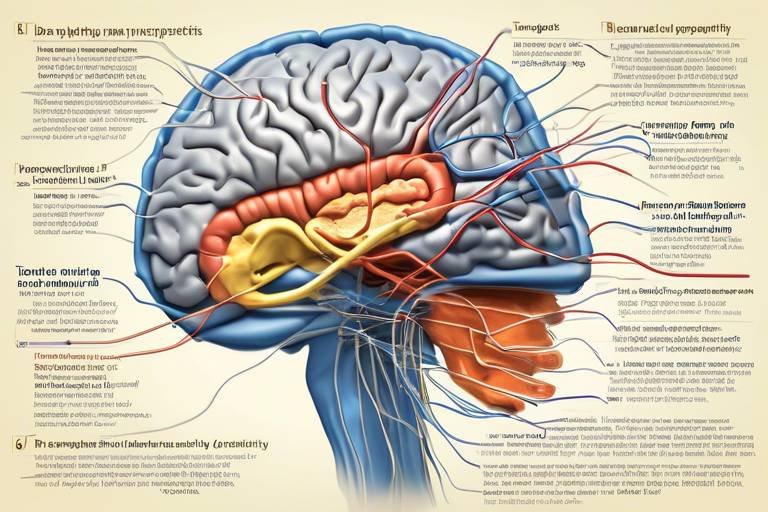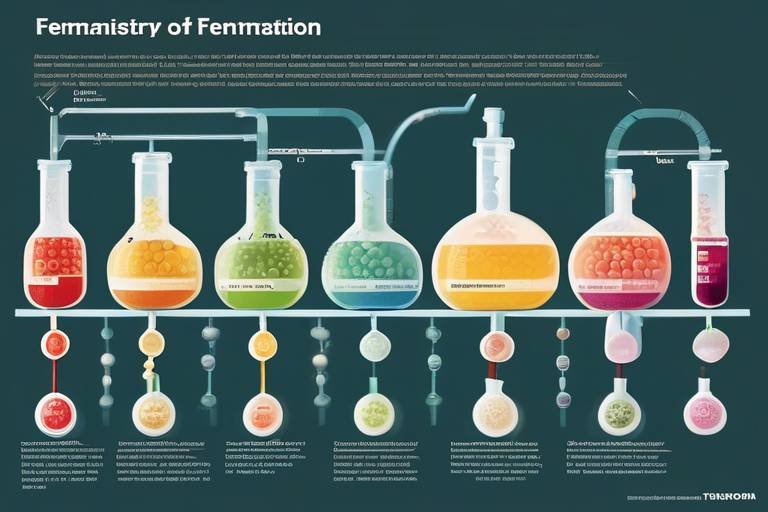Understanding the Biology of Insects - Friends or Foes?
Insects are some of the most intriguing creatures on our planet, often sparking a mix of admiration and aversion. With over a million known species, they represent the most diverse group of organisms on Earth. But what makes these tiny beings so fascinating? Their biological characteristics, ecological roles, and interactions with humans paint a complex picture that reveals both their beneficial and detrimental impacts on our world. From pollination to disease transmission, insects are integral to many processes that sustain life. This article aims to unravel the mysteries of these creatures, exploring their roles as both friends and foes in our ecosystems.
When we talk about diversity, insects take the crown. They exist in nearly every habitat imaginable, from the depths of the ocean to the highest mountains. Their ability to adapt is nothing short of remarkable. Insects can be classified into several orders, including Coleoptera (beetles), Lepidoptera (butterflies and moths), and Hymenoptera (bees and ants), each showcasing unique characteristics and adaptations. For instance, the wings of a butterfly are not just for flying; they play a crucial role in temperature regulation and camouflage. Insects have evolved various survival strategies, such as mimicry and camouflage, allowing them to thrive in environments that might otherwise be hostile.
Insects are often termed the unsung heroes of ecosystems. Their roles are multifaceted, contributing significantly to ecological balance and biodiversity. They serve as pollinators, decomposers, and a vital food source for many animals. For example, bees and butterflies are not just beautiful to observe; they are critical for the reproduction of many flowering plants. Without them, our food systems would face severe disruptions. Moreover, insects like ants and termites play a pivotal role in breaking down organic matter, enriching the soil and promoting plant growth.
Pollination is a critical process for plant reproduction, and insects are at the forefront of this essential task. Bees, butterflies, and other insects transfer pollen from one flower to another, facilitating the growth of fruits, vegetables, and nuts that are vital for human consumption. Did you know that approximately 75% of the world's flowering plants depend on animal pollinators? This statistic underscores the importance of insects in agriculture and food security. The implications for food production are staggering; without these tiny workers, our diets would be drastically less diverse.
Despite their importance, pollinators face numerous threats that jeopardize their populations. Habitat loss, pesticide use, and climate change are just a few of the challenges they encounter. Urbanization has led to the destruction of natural habitats, while the widespread use of chemical pesticides has harmful effects on insect health. Protecting these vital insects is crucial for maintaining ecological health and ensuring sustainable food systems. As stewards of the environment, we must recognize these threats and take action to mitigate their impact.
Fortunately, various initiatives are underway to conserve pollinator populations. Community gardens, wildlife corridors, and organic farming practices are just a few examples of successful strategies. Many organizations are also promoting awareness about the importance of pollinators and encouraging local communities to get involved. By planting native flowers and reducing pesticide use, we can create a more hospitable environment for these essential insects. Every little effort counts in the grand scheme of ecological preservation.
Decomposing insects, such as beetles and termites, are nature's recyclers. They break down organic matter, returning nutrients to the soil and supporting plant growth. This nutrient cycling is vital for maintaining soil health and fertility. Without these industrious insects, dead plant and animal material would accumulate, leading to nutrient depletion in ecosystems. Just like a well-functioning compost pile, insects ensure that waste is efficiently recycled, highlighting their importance in supporting life on Earth.
The relationship between insects and humans is a double-edged sword. While many insects provide valuable services, others can pose significant threats to our health and well-being. Understanding this complex interaction is crucial for managing our environment effectively. On one hand, beneficial insects contribute positively to agriculture and biodiversity. On the other hand, certain insects are vectors for diseases that can affect humans and animals alike, showcasing the need for a balanced perspective on these creatures.
Some insects are true allies in the agricultural sector. For instance, ladybugs and lacewings are natural predators of aphids, helping to control pest populations without the need for harmful chemicals. Additionally, earthworms, while not insects, play a crucial role in soil health, promoting aeration and nutrient cycling. The economic significance of these beneficial insects cannot be overstated; they contribute to higher crop yields and reduced reliance on synthetic pesticides, which can be costly and harmful to the environment.
Conversely, certain insects are notorious for spreading diseases that can have devastating impacts on human and animal health. Mosquitoes, for example, are vectors for diseases like malaria and dengue fever, affecting millions worldwide. Public health efforts aimed at controlling these insect populations are essential for mitigating their impact. Understanding the life cycles and behaviors of these insects can lead to more effective control measures, ensuring a healthier future for all.
- What is the most diverse group of insects? Coleoptera, or beetles, represent the largest group of insects with over 350,000 species identified.
- How do insects contribute to ecosystems? Insects play crucial roles as pollinators, decomposers, and as food sources for other animals, maintaining ecological balance.
- What are the threats to insect populations? Habitat loss, pesticide use, and climate change are significant threats to many insect species, particularly pollinators.
- How can we help conserve pollinators? Planting native flowers, reducing pesticide use, and supporting local conservation efforts are effective ways to help.

The Diversity of Insects
Insects are nothing short of a biological marvel, showcasing an astonishing diversity that is unparalleled in the animal kingdom. Did you know that there are over a million described species of insects? This staggering number accounts for more than half of all known living organisms on Earth! From the tiniest ants to the majestic butterflies, insects come in all shapes and sizes, each uniquely adapted to their environments. They inhabit virtually every corner of the globe, thriving in places as varied as lush rainforests, arid deserts, and even the icy tundras. This adaptability is a testament to their evolutionary success.
When we categorize insects, we often refer to their classifications based on taxonomy. They are primarily divided into several major orders, each with distinct characteristics. For instance, the order Coleoptera includes beetles, which are renowned for their hard outer wings, while Lepidoptera encompasses butterflies and moths, celebrated for their stunning colors and patterns. Other significant orders include:
- Hymenoptera: This group includes bees, wasps, and ants, known for their complex social structures.
- Diptera: Flies and mosquitoes fall under this category, recognized for their single pair of wings.
- Orthoptera: Grasshoppers and crickets belong here, famous for their jumping abilities and musical calls.
Insects have developed a myriad of adaptations that enable them to survive and thrive in diverse habitats. For example, some species have evolved to camouflage perfectly with their surroundings, while others have developed striking colors to warn predators of their toxicity. Many insects also exhibit fascinating behaviors; take the honeybee, for instance, which not only produces honey but also communicates with its hive through intricate dances to signal the location of food sources. This level of sophistication showcases the complex interactions insects have with their environment and each other.
Moreover, the reproductive strategies of insects are equally diverse. Some, like the housefly, produce hundreds of eggs at once, ensuring that at least a few will survive to adulthood. Others, such as certain species of butterflies, engage in elaborate courtship rituals to attract mates, highlighting the intricate dance of life that plays out in the insect world. This diversity in reproduction contributes significantly to the resilience and adaptability of insect populations.
As we explore the diversity of insects, it's essential to recognize their ecological roles. They are not just fascinating creatures to observe; they are integral to the health of our ecosystems. Their ability to adapt and thrive in various environments makes them key players in maintaining ecological balance. From pollination to decomposition, insects are the unsung heroes of the natural world, often going unnoticed yet playing crucial roles in sustaining life on our planet.
Q: Why are insects so diverse?
A: Insects have existed for over 400 million years, allowing them to evolve and adapt to a wide range of environments and ecological niches. Their small size and rapid reproduction rates also contribute to their diversity.
Q: How do insects contribute to ecosystems?
A: Insects play multiple roles, including pollination of plants, decomposition of organic matter, and serving as a food source for other animals. Their activities help maintain ecological balance.
Q: Are all insects harmful to humans?
A: No, while some insects can be pests or vectors for diseases, many are beneficial. For example, bees and butterflies are crucial for pollination, and ladybugs help control pest populations in gardens.

Insects in Ecosystems
Insects are often underestimated, but they are the unsung heroes of our ecosystems. These tiny creatures, with their incredible diversity and adaptability, play a multitude of roles that are vital for the health of our planet. From the buzzing bees to the industrious ants, insects contribute to ecological balance in ways that many people might not even realize. Have you ever thought about how many services these little critters provide? Let's dive deeper into their contributions!
One of the most significant roles insects play is as pollinators. Many plants depend on insects to transfer pollen from one flower to another, facilitating the process of reproduction. Without these pollinators, we would see a dramatic decline in the production of fruits, vegetables, and nuts. Did you know that approximately 75% of the world's flowering plants rely on animal pollination? This includes many crops that are essential to our diets, such as apples, almonds, and coffee. The loss of pollinators could lead to a food crisis, making the conservation of these insects crucial.
In addition to pollination, insects serve as decomposers. Think of them as nature's recyclers! Insects like beetles and termites break down dead plants and animals, returning nutrients back to the soil. This process not only enriches the soil but also supports the growth of new plants, creating a continuous cycle of life. Without these decomposers, organic matter would accumulate, and nutrients would remain locked away, unable to support new life. In fact, a healthy ecosystem relies on this intricate web of interactions.
Moreover, insects are a vital food source for many animals. Birds, mammals, and even reptiles depend on insects as a primary part of their diet. This connection makes insects integral to the food chain. If insect populations decline, it can lead to a ripple effect throughout the ecosystem, impacting species that rely on them for survival. It's a delicate balance that showcases the interconnectedness of life.
To illustrate the importance of insects in ecosystems, consider the following table that outlines their key roles:
| Role | Examples | Impact |
|---|---|---|
| Pollinators | Bees, butterflies, moths | Facilitate plant reproduction, enhance food production |
| Decomposers | Beetles, termites, ants | Recycle nutrients, enrich soil |
| Food Source | Birds, bats, amphibians | Support food webs and biodiversity |
In conclusion, insects are not just pesky bugs; they are crucial players in maintaining ecological balance. Their roles as pollinators, decomposers, and food sources highlight their importance in sustaining life on Earth. As we face challenges like habitat destruction and climate change, it’s vital to recognize and protect these remarkable creatures. They may be small, but their impact is anything but insignificant!
- Why are insects important for pollination? Insects transfer pollen between flowers, which is essential for plant reproduction and food production.
- How do insects contribute to soil health? Decomposing insects break down organic matter, returning nutrients to the soil, which supports new plant growth.
- What would happen if insect populations declined? A decline in insect populations could disrupt food webs, leading to negative impacts on other species and food production.

Pollination and Plant Reproduction
When you think about pollination, what comes to mind? Perhaps you envision a bee buzzing from flower to flower, or a butterfly gracefully landing on a petal. These tiny creatures play a monumental role in the cycle of life, particularly in the reproduction of plants. Insects, especially bees, butterflies, and moths, are nature's unsung heroes, ensuring that many of the fruits, vegetables, and nuts we enjoy are produced. Without them, our diets would look drastically different, and the biodiversity of our ecosystems would be at risk.
Pollination is the process where pollen from the male part of a flower (the anther) is transferred to the female part (the stigma), leading to fertilization and the eventual production of seeds. This process is vital for the reproduction of around 75% of the world’s flowering plants, which in turn provide food and habitat for countless species, including humans. Imagine a world without apples, almonds, or tomatoes! It’s hard to fathom, isn’t it?
Insects facilitate this crucial process in several ways. When they visit flowers to collect nectar, they inadvertently pick up pollen on their bodies and transfer it to other flowers as they continue their search for food. This not only aids in the reproduction of plants but also enhances genetic diversity, which is essential for the health of ecosystems. Here’s a quick look at how some key insects contribute:
| Insect Type | Role in Pollination | Examples of Plants Pollinated |
|---|---|---|
| Bees | Primary pollinators, highly efficient | Apples, Blueberries, Cucumber |
| Butterflies | Attracted to bright colors and sweet nectar | Milkweed, Lilies, Daisies |
| Moths | Pollinate at night, attracted to light | Evening Primrose, Jasmine |
However, it’s not just about the insects; plants have evolved fascinating adaptations to attract these pollinators. Bright colors, enticing scents, and even the shape of flowers can lure in specific insects. For instance, some flowers have evolved to be tubular, making them more accessible to hummingbirds and certain long-tongued insects. This intricate relationship between plants and insects showcases the beauty of nature's design and the interdependence of different species.
Yet, the world of pollination faces significant challenges. Factors such as habitat destruction, climate change, and pesticide use are putting immense pressure on these vital insect populations. If we continue down this path, we may find ourselves in a situation where the very insects that sustain our food systems are in peril. Protecting pollinators is not just an environmental issue; it’s a matter of food security and ecological health.
In conclusion, the relationship between insects and plant reproduction is a prime example of nature's intricate web of life. As we learn more about these connections, it becomes increasingly clear that protecting our pollinators is essential for maintaining the balance of our ecosystems and ensuring that future generations can enjoy the diversity of food that we often take for granted.
- What is pollination? Pollination is the transfer of pollen from the male part of a flower to the female part, leading to fertilization and seed production.
- Why are insects important for pollination? Insects are essential for pollination because they help fertilize plants, which is crucial for fruit and seed production.
- What can be done to protect pollinators? We can protect pollinators by planting native flowers, reducing pesticide use, and creating habitats that support their populations.

Threats to Pollinators
Pollinators, those tiny heroes of our ecosystems, face a myriad of challenges that threaten their survival and, consequently, the health of our planet. Imagine a world without vibrant flowers or delicious fruits—it's a frightening thought, isn't it? The reality is that factors such as habitat loss, pesticide use, climate change, and disease are putting immense pressure on these essential creatures.
One of the primary threats to pollinators is habitat loss. Urbanization, agricultural expansion, and deforestation are rapidly diminishing the natural environments where these insects thrive. When wild spaces are replaced with concrete jungles or monoculture farms, pollinators lose their food sources and nesting sites. This loss of biodiversity not only impacts pollinators but also disrupts the entire ecosystem.
Another significant danger is the widespread use of pesticides. Chemicals designed to eliminate pests can be indiscriminate, harming beneficial insects like bees and butterflies. The impact of neonicotinoids, a class of neurotoxic pesticides, has been particularly alarming, leading to disorientation, reduced reproductive success, and even death among pollinator populations. The irony is that while farmers aim to protect their crops, they may inadvertently be jeopardizing the very insects that help those crops flourish.
Climate change is also playing a pivotal role in altering the dynamics of pollinator populations. As temperatures rise and weather patterns shift, the timing of flowering plants can become misaligned with the life cycles of their pollinators. This phenomenon, known as phenological mismatch, can lead to reduced pollination success and ultimately threaten food production. For instance, if flowers bloom earlier due to warmer temperatures, but pollinators are not yet active, the plants may not receive the necessary pollination to produce seeds and fruits.
Moreover, diseases and parasites pose a serious threat to pollinator health. For example, the Varroa destructor mite is a notorious enemy of honeybees, weakening their immune systems and making them more susceptible to viruses. The spread of these diseases can decimate entire colonies, leading to significant declines in pollinator populations. As these threats accumulate, the survival of these vital insects hangs in the balance.
To combat these threats, it is crucial for us to recognize the importance of protecting pollinators. By creating pollinator-friendly habitats, reducing pesticide use, and supporting sustainable agricultural practices, we can help ensure these insects continue to thrive. Community efforts, such as planting native flowers and establishing bee gardens, can make a significant difference. Every small action counts, and together, we can contribute to a healthier ecosystem.
- What are the main threats to pollinators? Habitat loss, pesticide use, climate change, and diseases are the primary threats.
- How can I help protect pollinators? You can plant native flowers, reduce pesticide use, and create habitats that support pollinators.
- Why are pollinators important? Pollinators play a critical role in plant reproduction, which is essential for food production and maintaining biodiversity.

Conservation Efforts
Conservation efforts aimed at protecting pollinators are more crucial than ever. As we witness alarming declines in bee populations and other essential pollinators, various initiatives have emerged globally to address these challenges. These efforts not only focus on raising awareness but also on implementing practical strategies to create a more sustainable environment for these vital insects.
One of the most effective approaches involves habitat restoration. By reintroducing native plants into urban and rural landscapes, we can create safe havens for pollinators. Native plants are adapted to local climates and provide the necessary food sources that insects rely on. For instance, community gardens and wildflower meadows are becoming increasingly popular as they offer a diverse range of flowering plants that bloom at different times, ensuring a continuous food supply throughout the seasons.
Moreover, educational programs play a pivotal role in conservation. Schools, local governments, and non-profit organizations are collaborating to educate the public about the importance of pollinators. Workshops, seminars, and interactive activities help people understand how their actions can positively impact these insects. For example, simple practices like reducing pesticide use and planting pollinator-friendly gardens can make a significant difference.
In addition to these grassroots efforts, governmental policies are being revised to include stronger protections for pollinators. Many countries are implementing regulations that limit the use of harmful pesticides and promote sustainable agricultural practices. These policies are essential in creating a safer environment for pollinators, ensuring that they can thrive without the threat of chemical exposure.
Another innovative conservation effort is the establishment of pollinator corridors. These are designated areas that connect habitats, allowing insects to move freely between them. This connectivity is vital for pollinators as it enables them to find food, reproduce, and maintain genetic diversity. For example, cities are beginning to incorporate green roofs and vertical gardens, which not only beautify urban spaces but also serve as critical habitats for pollinators.
Community involvement is also a key factor in conservation success. Local volunteers often participate in clean-up events, tree planting, and the installation of bee hotels, which provide nesting sites for solitary bees. These hands-on initiatives foster a sense of ownership and responsibility towards the environment, encouraging individuals to take action in their own backyards.
In conclusion, the fight to conserve pollinator populations is a multifaceted approach that requires collaboration between individuals, communities, and governments. By restoring habitats, educating the public, enacting supportive policies, establishing pollinator corridors, and promoting community involvement, we can create a brighter future for these indispensable insects. Remember, every small action counts, and together, we can make a significant impact in safeguarding our pollinators for generations to come.
- Why are pollinators important? Pollinators are essential for the reproduction of many plants, including crops, which contribute to our food supply and overall ecosystem health.
- What can I do to help pollinators? You can create pollinator-friendly gardens, reduce pesticide use, and participate in local conservation efforts.
- What are some common threats to pollinators? Habitat loss, pesticide use, climate change, and diseases are significant threats that pollinators face today.
- How can I get involved in conservation efforts? Look for local organizations focused on pollinator conservation, volunteer for community projects, or start your own pollinator garden.

Insects as Decomposers
When you think of insects, you might picture buzzing bees or pesky mosquitoes, but there's a whole world of unsung heroes in the insect realm, particularly those that serve as decomposers. These remarkable creatures, such as beetles, termites, and certain ants, play a vital role in our ecosystem by breaking down organic matter. Imagine walking through a forest after a storm; fallen leaves, dead trees, and other organic debris litter the ground. Without decomposers, this organic waste would accumulate, leading to a buildup of dead material that could choke the life out of the ecosystem. Instead, these industrious insects get to work, recycling nutrients and ensuring that life continues to flourish.
Decomposing insects are nature's cleanup crew. They feed on dead plant and animal material, breaking it down into simpler substances that can be reused in the ecosystem. This process not only helps in nutrient cycling but also improves soil health. For instance, when termites consume wood, they break it down into smaller particles, which then enrich the soil. This nutrient recycling is essential for plant growth, making insects critical players in maintaining ecological balance.
Moreover, the contributions of decomposing insects extend beyond just nutrient cycling. They also help in carbon sequestration. As they break down organic matter, they release carbon back into the soil, where it can be stored for long periods. This process is crucial in combating climate change, as it helps regulate atmospheric carbon levels. In a way, these tiny creatures are working tirelessly behind the scenes to combat one of the biggest challenges we face today.
To appreciate the importance of these decomposers, consider the following key roles they play:
- Nutrient Recycling: They break down complex organic materials into simpler compounds that enrich the soil.
- Soil Aeration: Insects like ants and beetles burrow into the ground, allowing air and water to penetrate deeper into the soil.
- Habitat Creation: Their activity creates a diverse habitat for other organisms, fostering biodiversity.
In short, the role of insects as decomposers is indispensable. They are not just scavengers; they are pivotal to the health of our ecosystems. Without them, we would face a world overwhelmed by waste, devoid of the rich, fertile soil that supports plant life. So, the next time you see a beetle scuttling across the ground or a termite munching on wood, remember that these little creatures are doing some of the most important work on our planet.
Q: Why are decomposing insects important for the environment?
A: Decomposing insects play a crucial role in recycling nutrients, improving soil health, and supporting plant growth, which is essential for maintaining ecological balance.
Q: What types of insects are considered decomposers?
A: Common decomposing insects include beetles, termites, ants, and certain types of flies that feed on decaying organic matter.
Q: How do decomposing insects contribute to carbon sequestration?
A: As decomposing insects break down organic materials, they help release carbon into the soil, where it can be stored, thereby aiding in the regulation of atmospheric carbon levels.

Insects and Human Interaction
The relationship between insects and humans is a captivating tapestry woven with threads of both benefits and challenges. On one hand, these tiny creatures are our unsung heroes, contributing significantly to agriculture and the environment. On the other hand, some insects can be downright troublesome, spreading diseases and causing economic losses. Understanding this duality is essential for fostering a balanced perspective on our interactions with these fascinating organisms.
Insects play a pivotal role in agriculture, where they act as natural pest controllers. For instance, ladybugs and lacewings feast on aphids and other harmful pests, reducing the need for chemical pesticides. This not only helps farmers save money but also promotes a healthier ecosystem. The economic significance of beneficial insects is staggering; a study estimates that their contributions to crop yields can be valued in the billions of dollars annually. Without these tiny allies, our food production systems would be far less sustainable.
However, not all interactions with insects are positive. Some species, such as mosquitoes and ticks, are notorious for transmitting diseases that pose serious health risks to humans and animals alike. Diseases like malaria, dengue fever, and Lyme disease are just a few examples of how these little creatures can wreak havoc on public health. The World Health Organization reports that insect-borne diseases account for millions of deaths each year, highlighting the urgent need for effective control measures.
To combat the threats posed by harmful insects, public health initiatives have been developed. These efforts often focus on education, prevention, and control strategies. For instance, community awareness programs educate people on how to reduce mosquito breeding sites, while also promoting the use of insect repellent and protective clothing during peak activity times. As we navigate the complexities of these interactions, it becomes increasingly clear that a multifaceted approach is necessary to manage the risks while still reaping the benefits that insects provide.
Insects also contribute to our economy in unexpected ways. The silk industry, for example, relies on silkworms, which have been cultivated for thousands of years. Similarly, honeybees not only produce honey but also support the pollination of various crops, further enhancing agricultural productivity. The economic impact of these insects is significant, and their contributions are often underestimated.
As we delve deeper into the world of insects, it’s essential to recognize the intricate balance they maintain within our ecosystems and economies. By fostering a better understanding of their roles, we can work towards solutions that protect both human health and insect populations. After all, in this complex web of life, every creature has its part to play.
- What are some beneficial insects for agriculture?
Beneficial insects include ladybugs, lacewings, and parasitic wasps, which help control pest populations naturally. - How can I protect myself from insect-borne diseases?
To protect yourself, use insect repellent, wear long sleeves, and eliminate standing water where mosquitoes breed. - Why are pollinators important?
Pollinators are crucial for the reproduction of many plants, including crops that humans rely on for food. - What are some conservation efforts for insects?
Conservation efforts include creating pollinator gardens, reducing pesticide use, and supporting habitat restoration initiatives.

Beneficial Insects in Agriculture
When we think of agriculture, we often picture vast fields, farmers toiling under the sun, and the bounty of crops ready for harvest. However, what many people overlook is the invisible army working tirelessly behind the scenes: beneficial insects. These tiny creatures play a monumental role in ensuring our food systems are robust and sustainable. From pollination to pest control, beneficial insects are nature's unsung heroes.
One of the most prominent examples of beneficial insects is the honeybee. These hardworking pollinators are responsible for pollinating approximately one-third of the food we consume. Without them, fruits, vegetables, and nuts would be scarce, leading to a significant drop in food production. Imagine a world without apples, almonds, or strawberries! The impact would be devastating. In addition to bees, other insects like butterflies and moths also contribute to the pollination process, ensuring that plants can reproduce and thrive.
Insects also serve as natural pest controllers. For instance, ladybugs are known to feast on aphids, which are notorious for damaging crops. By keeping pest populations in check, these beneficial insects reduce the need for chemical pesticides, which can have harmful effects on the environment and human health. This natural form of pest management not only protects crops but also promotes a healthier ecosystem. It's a win-win situation!
Moreover, some insects, such as certain types of wasps, are parasitic and target pest insects, laying their eggs inside them. This method of biological control is incredibly effective and helps maintain the balance in agricultural environments. The use of beneficial insects in agriculture can significantly reduce the reliance on synthetic pesticides, leading to more sustainable farming practices.
To put it simply, beneficial insects are essential for maintaining healthy agricultural ecosystems. They contribute to food security and help farmers produce higher yields while minimizing environmental impacts. By understanding their role, we can better appreciate the delicate balance of nature and work towards protecting these vital species.
- What are some other examples of beneficial insects? In addition to bees and ladybugs, beneficial insects include predatory beetles, lacewings, and certain types of ants.
- How can farmers attract beneficial insects to their fields? Farmers can plant diverse crops, maintain flowering plants, and avoid using harmful pesticides to create an inviting habitat for beneficial insects.
- Are all insects harmful to agriculture? No, while some insects are pests, many play crucial roles in pollination and pest control, benefiting agricultural practices.

Insect-Borne Diseases
Insects, while often overlooked, can be significant players in the transmission of diseases that affect humans and animals. These tiny creatures can carry pathogens such as viruses, bacteria, and parasites, making them formidable foes in public health. For instance, mosquitoes are notorious for spreading diseases like malaria, dengue fever, and Zika virus. But how do these insects become vectors for such serious health threats? It all starts with their feeding habits. When an infected insect bites a host, it can transfer the disease-causing agents into the bloodstream, leading to infections that can have devastating consequences.
Consider the mosquito: a common nuisance that can ruin a summer evening, yet it also has the potential to cause significant health crises. According to the World Health Organization, mosquito-borne diseases account for over 700,000 deaths annually. This staggering figure highlights the importance of understanding these insects and the diseases they carry. Not only do these diseases impact individual health, but they can also strain healthcare systems and economies, particularly in developing countries where resources are limited.
Another example is the tick, which is infamous for transmitting Lyme disease and other tick-borne illnesses. Ticks latch onto their hosts, feeding on blood while simultaneously injecting pathogens. The rise in tick populations, partly due to climate change, has led to an increase in reported cases of Lyme disease in various regions, raising alarms among health officials. This situation illustrates the interconnectedness of environmental factors and public health.
To better understand the impact of insect-borne diseases, let's take a look at a few key diseases and their vectors:
| Disease | Vector | Symptoms | Prevention |
|---|---|---|---|
| Malaria | Mosquito | Fever, chills, headache | Insecticide-treated nets, antimalarial drugs |
| Dengue Fever | Mosquito | High fever, severe headache, joint pain | Eliminating standing water, using repellents |
| Lyme Disease | Tick | Rash, fever, fatigue | Wearing protective clothing, tick removal |
These examples underscore the critical need for public awareness and preventive measures. Education plays a vital role in combating the spread of insect-borne diseases. By informing communities about how to protect themselves from insect bites and the importance of seeking medical attention when symptoms arise, we can mitigate the risks associated with these diseases. Moreover, ongoing research into vaccines and treatments is essential to curb the impact of these diseases on global health.
In conclusion, while insects may seem like mere pests, their ability to transmit diseases poses a serious threat to human health. The intricate relationship between insects and the pathogens they carry necessitates a multi-faceted approach to public health, including education, prevention strategies, and continued research. As we navigate the complexities of our interactions with these tiny adversaries, it becomes clear that understanding their biology and behavior is crucial in our fight against insect-borne diseases.
- What are the most common insect-borne diseases? Some of the most common include malaria, dengue fever, and Lyme disease.
- How can I protect myself from insect bites? Use insect repellent, wear long sleeves, and eliminate standing water around your home.
- Are there vaccines available for insect-borne diseases? Yes, there are vaccines for certain diseases like malaria and dengue fever, but research is ongoing.
- What should I do if I suspect I have an insect-borne disease? Seek medical attention immediately for proper diagnosis and treatment.
Frequently Asked Questions
- What are the primary roles of insects in ecosystems?
Insects play several vital roles in ecosystems, acting as pollinators, decomposers, and a food source for a variety of animals. Without them, many plants would struggle to reproduce, and nutrient cycling would be severely disrupted, leading to imbalances in the ecosystem.
- How do insects contribute to pollination?
Insects, especially bees and butterflies, are crucial for pollination. They transfer pollen from one flower to another, facilitating plant reproduction. This process is essential not only for wild plants but also for many crops that humans rely on for food.
- What threats do pollinators face today?
Pollinators are facing numerous threats, including habitat loss, pesticide use, and climate change. These factors can lead to declining populations, which poses a significant risk to both biodiversity and food production.
- What can be done to protect pollinator populations?
Conservation efforts are underway to protect pollinator populations. Strategies include creating pollinator-friendly habitats, reducing pesticide use, and raising public awareness about the importance of these insects. Community involvement is key to these initiatives.
- How do insects help in nutrient cycling?
Decomposing insects, such as beetles and termites, break down dead organic matter, returning essential nutrients to the soil. This process is vital for maintaining soil health and fertility, ensuring that ecosystems can thrive.
- What are some beneficial insects in agriculture?
Many insects contribute positively to agriculture by controlling pest populations and enhancing crop yields. For example, ladybugs feed on aphids, while certain wasps can help manage pest populations, ultimately benefiting farmers and the economy.
- What are insect-borne diseases?
Insect-borne diseases are illnesses transmitted to humans and animals through insect vectors, such as mosquitoes and ticks. Examples include malaria, dengue fever, and Lyme disease. Understanding these risks is crucial for public health efforts aimed at mitigating their impact.



















